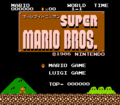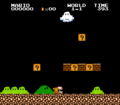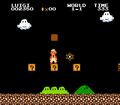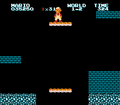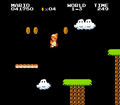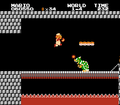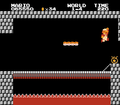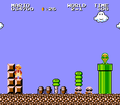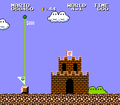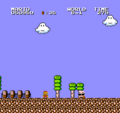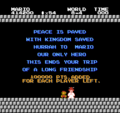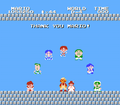User:Conradd/Viva Kingdom
Viva Kingdom (VERY WIP)
| Viva Kingdom | |
|---|---|
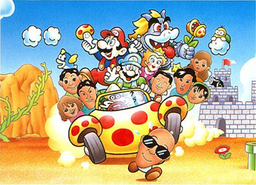 Viva Kingdom as seen on the box cover of All Night Nippon Super Mario Bros. | |
| First appearance | All Night Nippon Super Mario Bros. (1986) |
| Ruler | Princess Peach |
| Inhabitants | Miyuki, Takaaki, Noritake, KYON², Takeshi, Matchan, Hidechan, Sunplaza Nakano, Unnamed Worlds A-C human. |
The Viva Kingdom (also known as All Night Nippon dream land) is the main setting where the events of All Night Nippon Super Mario Bros. takes place. This place looks a lot like the Mushroom Kingdom as it appears in Super Mario Bros. and Super Mario Bros.: The Lost Levels. Given the very nature of the game, it's unknown if both kingdoms are present on Mario's planet or if they are part of parallel universes where the two cannot co-exist simultaneously.
NB: Investigate the meaning of the sentence: "All Night Nippon' dream land". https://en.wikipedia.org/wiki/List_of_former_sovereign_states https://en.wikipedia.org/wiki/List_of_sovereign_states_by_date_of_formation
Geography
Like its fungal counterpart, Viva Kingdom has meadows (every -4 except D-4 & 6-3); hills (1-1; 1-2; 4-1; 6-1; 6-2; and all of World D); snowy biomes; tropical biomes; coral reefs; Bonus Stages above the clouds that can only be accessed with a Beanstalk cointained in ? Blocks and fields of Super Mushrooms. This country also has many man-made structures such as fortresses; castles which are filled with lava (every -4), some containing labyrinth-like structures; bridges; and a lot of Warp Pipe systems deployed throughout the realm, some of them connected to Warp Zones and underground caves only accessible by said pipes. Viva Kingdom also has its fair share of originality, such as the numerous microphones that litter some of its countries, which could suggest that at least part of the territory has radio/music-themed biomes.
Geographic structure:
- meadows: every -4 (except D-4) & 6-3 [done]
- hills: 1-1; 1-2; 4-1; 6-1; 6-2; and all of World D [done]
- underground caves: every -1 (except 6-1); 1-2; 4-2; 6-2; 8-2; A-2; D-2 & D-4
- Bonus Stages: 2-1; 3-1; 5-2; 6-2; A-1; B-1; C-1; D-1 & D-2
- body of water: 2-2; 3-1; 5-2; 6-2; 7-2; B-2 & D-1
Flora:
- horsetail: 2-1; 2-2; 3-1; 3-2; 4-2; 5-1; 5-2; 7-1; 7-2; 8-1; 8-2; 8-3; A-1; A-2; B-1; B-2 & C-1
- automun: A-1 [done]
- snowy biomes: 3-1; 3-2; 5-1; 5-2; 6-3; 7-1; B-3; C-3; D-1; D-2 & D-3
- (body of water) tropical biomes: 1-3; 2-3; 3-3; 5-3; 7-3; B-3; C-2 & C-3
- (body of water) coral reefs: 2-2; 5-2; 6-2; 7-2 & B-2
- fields of Super Mushrooms: 4-2; 4-3 & A-3
Man-made:
Castles propeties:
- fortresses: every world except -4 & B-4(?)
- castles filled with lava: every -4 [done]
- wall: 8-3; A-3; B-4(?) & D-3 [done]
- labyrinth: 4-4; 7-4 & 8-4 [done]
Pipes:
- Warp Pipe system: 1-1; 1-2; 2-1; 2-2; 3-1; 3-2; 4-1; 4-2; 4-4; 5-1; 5-2; 6-1; 6-2; 6-4; 7-1; 7-2; 8-1; 8-2; 8-3; 8-4; A-1; A-2; A-3; B-1; B-2; B-3; B-4; C-1; C-3; D-1; D-2; D-3 & D-4
- warp zone: 1-2; 4-2; A-2; A-3 & B-4
Others:
- conveiller platform: 2-4 [done]
- (some castle prop) staircase: 1-1; 1-2; 1-3(?); 2-2; 2-3; 3-1; 3-2; 4-1; 4-2; 5-1; 5-2; 6-1; 6-2; 7-1; 7-2; 7-3(?); 8-1; 8-3(?); A-1; A-2; A-3; B-1; B-2; B-4; C-1; C-2; D-2 & D-4
- bridges: 1-4; 2-3; 2-4; 3-1; 3-4; 4-4; 5-4; 6-4; 7-3; 7-4; 8-4; A-4; B-4; C-2; C-4 & D-4
- microphones: 2-1, 2-2, 3-1, 3-2, 4-2, 5-1, 5-2, 7-1, 7-2, 8-1, 8-2, 8-3, A-1, A-2, B-1, B-2 & C-1
Day-night cycle:
- night: 1-1; 1-2; 1-3; 3-1; 3-2; 3-3; 6-1; 6-2; 6-3; C-1 & C-2
Physical features
Plants stick out throughout Subcon, which, when pulled, will give the character a vegetable, 1-Up Mushroom, POW Block, or, occasionally, a Bomb. A lot of the region of Subcon is high in the sky, as clouds would be considered "land". The dream world has many moons at night as first seen in Super Mario All-Stars. Subcon also has many recurring landscapes, such as grasslands, deserts with pyramids, snowy islands, and others. The only castle structure is Wart's factory, and no towns or cities are seen throughout the game. Super Mario All-Stars added jungle trees (Worlds 1, 3 & 5), mountains and Egyptian palaces in the desert distance (Worlds 2 & 6) and floating Greek-style temples (World 7) as background objects. According to BS Super Mario USA, Subcon has a kingdom and a king. It is not known how much of Subcon is considered a true kingdom; if not the entirety of the dream world, seventh world in the clouds of Subcon above the grass or the desert region is probably the whole region of the kingdom itself. The factory from World 7-2 is actually the king's castle.
Government
The Viva Kingdom is ruled by Princess Peach. The kingdom's capital is Toad Town. Here, Princess Peach resides in her castle. Early material also includes her father, the kindly Mushroom King, who is mentioned to rule alongside her. However, he largely does not appear later in the series.
Princess Peach keeps a horde of Toad guards at her castle. However, Mario, Luigi, and many other heroes of the Mushroom Kingdom have fought to save it and its princess countless times before. Currently, Princess Peach staffs and supports Toad Houses in major towns near Toad Town.
- If both kingdoms are part of parallel universes -> Peach is simply the leader of the Viva Kingdom, the Mushroom Kingdom equivalent of this reality.
- If both kingdoms are present on the same planet -> Peach could have annexed the kingdom, or the kingdom is part of the Mushroom Kingdom jurisdiction, somehow. (Commonwealth?)
NB: Investigate the meaning of the sentence: "All Night Nippon' dream land".
Currency
Viva Kingdom uses coins as currency, similar to the Mushroom Kingdom, round and gold with another circle in the center. Coins are very common. Scattered throughout the kingdom, they can be found on the ground; suspended in the air or underwater; contained individually in ? Blocks or up to sixteen in Brick Blocks. Extra lives in the form of 1-Up Mushroom are given as a reward for every 100 coins collected. Each coin has a value of 1.
![]()
![]()
Demographics
Subcon's natural population consists of mostly Subcons, although the seldom-seen king and his aide appear to be human. During Wart's takeover, several monsters were artificially created, although some existing creatures like Albatoss and Tryclyde were merely enlisted to his forces. Other creatures resembling those from the real world are also known to exist, such as whales residing in icy territory.
Species of the Viva Kingdom
- https://www.mariowiki.com/Mushroom_Kingdom
- https://www.mariowiki.com/Mushroom_Kingdom_Hospital
- https://www.mariowiki.com/Antarctica
- https://www.mariowiki.com/Earth
- https://www.mariowiki.com/Dinosaur_Land
- https://www.mariowiki.com/New_York_City
- https://www.mariowiki.com/Wario%27s_Woods_(location)
- https://www.mariowiki.com/Northern_Kremisphere
- https://www.mariowiki.com/Donkey_Kong_Island
- https://www.mariowiki.com/DK_Isles
- https://www.mariowiki.com/Crocodile_Isle_(Donkey_Kong_64)
- https://www.mariowiki.com/Banana_Fairy_Island
- https://www.mariowiki.com/Jewelry_Land
- https://www.mariowiki.com/Brooklyn
- https://www.mariowiki.com/Super_Mario_RPG:_Legend_of_the_Seven_Stars#Storyline
- https://www.mariowiki.com/Donkey_Kong_Country_2:_Diddy%27s_Kong_Quest#Story
- https://www.mariowiki.com/Super_Mario_World_2:_Yoshi%27s_Island#Story
- https://www.mariowiki.com/Donkey_Kong_Country#Story
- https://www.mariowiki.com/Dr._Mario_64#Plot
- https://www.mariowiki.com/Mario_Party_3#Story_and_objective
- https://www.mariowiki.com/Paper_Mario#Storyline
- https://www.mariowiki.com/Mario_Party_2#Story
- https://www.mariowiki.com/Donkey_Kong_64#Story
- https://www.mariowiki.com/Mario_Party#Story
- https://www.mariowiki.com/Yoshi%27s_Story#Story
- https://www.mariowiki.com/Diddy_Kong_Racing#Story
- https://www.mariowiki.com/Super_Mario_64#Storyline
- https://www.mariowiki.com/Super_Mario_Strikers#Opening_cutscene
- https://www.mariowiki.com/Mario_Party_7#Story
- https://www.mariowiki.com/Mario_Superstar_Baseball#Cutscenes
- https://www.mariowiki.com/Dance_Dance_Revolution:_Mario_Mix#Story_Mode
- https://www.mariowiki.com/Donkey_Kong_Jungle_Beat#Story
- https://www.mariowiki.com/Mario_Party_6#Story
- https://www.mariowiki.com/Mario_Power_Tennis#Opening
- https://www.mariowiki.com/Paper_Mario:_The_Thousand-Year_Door#Plot
- https://www.mariowiki.com/Donkey_Konga_2#Story
- https://www.mariowiki.com/Donkey_Konga#Story
- https://www.mariowiki.com/Mario_Party_5#Story
- https://www.mariowiki.com/Mario_Golf:_Toadstool_Tour#Opening
- https://www.mariowiki.com/Wario_World#Storyline
- https://www.mariowiki.com/Mario_Party_4#Plot
- https://www.mariowiki.com/Super_Mario_Sunshine#Story
- https://www.mariowiki.com/Luigi%27s_Mansion#Story
- https://www.mariowiki.com/Mario_Party_9#Story
- https://www.mariowiki.com/Mario_Sports_Mix#Story
- https://www.mariowiki.com/Donkey_Kong_Country_Returns#Story
- https://www.mariowiki.com/Super_Mario_Galaxy_2#Story
- https://www.mariowiki.com/New_Super_Mario_Bros._Wii#Story
- https://www.mariowiki.com/New_Play_Control!_Donkey_Kong_Jungle_Beat#Story
- https://www.mariowiki.com/Captain_Rainbow#Story
- https://www.mariowiki.com/Wario_Land:_Shake_It!#Story
- https://www.mariowiki.com/Super_Smash_Bros._Brawl#Plot
- https://www.mariowiki.com/Super_Mario_Galaxy#Story
- https://www.mariowiki.com/Mario_Party_8#Story
- https://www.mariowiki.com/Mario_Strikers_Charged#Opening_cutscene
- https://www.mariowiki.com/Super_Paper_Mario#Story
- https://www.mariowiki.com/WarioWare:_Smooth_Moves#Story
- https://www.mariowiki.com/Paper_Mario:_Color_Splash#Story
- https://www.mariowiki.com/Yoshi%27s_Woolly_World#Story
- https://www.mariowiki.com/Captain_Toad:_Treasure_Tracker#Story
- https://www.mariowiki.com/Donkey_Kong_Country:_Tropical_Freeze#Story
- https://www.mariowiki.com/Super_Mario_3D_World#Story
- https://www.mariowiki.com/Game_%26_Wario#Story
- https://www.mariowiki.com/New_Super_Mario_Bros._U#Story
- https://www.mariowiki.com/Mario_%2B_Rabbids_Sparks_of_Hope#Plot
- https://www.mariowiki.com/WarioWare:_Get_It_Together!#Story
- https://www.mariowiki.com/Mario_Golf:_Super_Rush#Story
- https://www.mariowiki.com/Super_Mario_3D_World_%2B_Bowser%27s_Fury#Story
- https://www.mariowiki.com/Paper_Mario:_The_Origami_King#Plot
- https://www.mariowiki.com/Mario_%26_Sonic_at_the_Olympic_Games_Tokyo_2020#Story_Mode
- https://www.mariowiki.com/Luigi%27s_Mansion_3#Story
- https://www.mariowiki.com/Super_Mario_Maker_2#Story_Mode
- https://www.mariowiki.com/Yoshi%27s_Crafted_World#Story
- https://www.mariowiki.com/New_Super_Mario_Bros._U_Deluxe#Cutscenes
- https://www.mariowiki.com/Super_Smash_Bros._Ultimate#Adventure
- https://www.mariowiki.com/Super_Mario_Party#Story
- https://www.mariowiki.com/Mario_Tennis_Aces#Story
- https://www.mariowiki.com/Super_Mario_Odyssey#Story
- https://www.mariowiki.com/Mario_%2B_Rabbids_Kingdom_Battle#Story
- https://www.mariowiki.com/Donkey_Kong_3_(Game_%26_Watch)#Story
- https://www.mariowiki.com/Super_Mario_Bros._(Game_%26_Watch)#Story
- https://www.mariowiki.com/Donkey_Kong_II#Story
- https://www.mariowiki.com/Donkey_Kong_(Game_%26_Watch)
- https://www.mariowiki.com/VS._Super_Mario_Bros.#Story
- https://www.mariowiki.com/Virtual_Boy_Wario_Land#Story
- https://www.mariowiki.com/Mario_Clash#Story
- https://www.mariowiki.com/Wario_Land_II#Story
- https://www.mariowiki.com/Donkey_Kong_Land_2#Story
- https://www.mariowiki.com/Donkey_Kong_Land#Story
- https://www.mariowiki.com/Wario_Blast:_Featuring_Bomberman!#Story
- https://www.mariowiki.com/Donkey_Kong_(Game_Boy)#Story
- https://www.mariowiki.com/Wario_Land:_Super_Mario_Land_3#Plot
- https://www.mariowiki.com/Yoshi%27s_Cookie#Cutscenes
- https://www.mariowiki.com/Super_Mario_Land_2:_6_Golden_Coins#Story
- https://www.mariowiki.com/Dr._Mario_(game)#Story
- https://www.mariowiki.com/Super_Mario_Land#Story
- https://www.mariowiki.com/Subcon
- https://www.mariowiki.com/Mario_Tennis_(Game_Boy_Color)#Mario_Tour_(story_mode)
- https://www.mariowiki.com/Wario_Land_3#Story
- https://www.mariowiki.com/Donkey_Kong_Land_III#Story
- https://www.mariowiki.com/Super_Mario_Bros._Deluxe#Story
- https://www.mariowiki.com/Mario_Tennis:_Power_Tour#Plot
- https://www.mariowiki.com/DK:_King_of_Swing#Story
- https://www.mariowiki.com/Mario_Party_Advance#Story
- https://www.mariowiki.com/Yoshi_Topsy-Turvy#Story
- https://www.mariowiki.com/WarioWare:_Twisted!#Story
- https://www.mariowiki.com/Mario_Pinball_Land#Story
- https://www.mariowiki.com/Mario_vs._Donkey_Kong#Story
- https://www.mariowiki.com/Mario_Golf:_Advance_Tour#Story
- https://www.mariowiki.com/Mario_%26_Luigi:_Superstar_Saga#Story
- https://www.mariowiki.com/Super_Mario_Advance_4:_Super_Mario_Bros._3#Story
- https://www.mariowiki.com/WarioWare,_Inc.:_Mega_Microgame$!#Story
- https://www.mariowiki.com/Yoshi%27s_Island:_Super_Mario_Advance_3#Story
- https://www.mariowiki.com/Super_Mario_World:_Super_Mario_Advance_2#Cutscenes
- https://www.mariowiki.com/Wario_Land_4#Story
- https://www.mariowiki.com/Super_Mario_Advance#Story
- https://www.mariowiki.com/Mario_vs._Donkey_Kong:_Mini-Land_Mayhem!#Story
- https://www.mariowiki.com/Mario_%26_Sonic_at_the_Olympic_Winter_Games_(Nintendo_DS)#Adventure_Tours_story
- https://www.mariowiki.com/WarioWare:_D.I.Y.#Storyline
- https://www.mariowiki.com/Mario_%26_Luigi:_Bowser%27s_Inside_Story#Story
- https://www.mariowiki.com/Mario_Party_DS#Story
- https://www.mariowiki.com/DK:_Jungle_Climber#Plot
- https://www.mariowiki.com/Diddy_Kong_Racing_DS#Story
- https://www.mariowiki.com/Wario:_Master_of_Disguise#Storyline
- https://www.mariowiki.com/Yoshi%27s_Island_DS#Story
- https://www.mariowiki.com/Mario_vs._Donkey_Kong_2:_March_of_the_Minis#Storyline
- https://www.mariowiki.com/New_Super_Mario_Bros.#Story
- https://www.mariowiki.com/Mario_%26_Luigi:_Partners_in_Time#Story
- https://www.mariowiki.com/Super_Princess_Peach#Story
- https://www.mariowiki.com/Yoshi_Touch_%26_Go#Story
- https://www.mariowiki.com/Super_Mario_64_DS#Plot
- https://www.mariowiki.com/WarioWare:_Touched!#Story
- https://www.mariowiki.com/Mario_vs._Donkey_Kong:_Minis_March_Again!#Storyline
- https://www.mariowiki.com/Mario_Clock#Nintendo_DSi_Shop_description
- https://www.mariowiki.com/Mario_Calculator#DSi_Shop_description
- https://www.mariowiki.com/WarioWare:_Snapped!#Plot
- https://www.mariowiki.com/Bird_%26_Beans#DSi_Shop_description
- https://www.mariowiki.com/Paper_Airplane_Chase#DSi_Shop_description
- https://www.mariowiki.com/Dr._Mario_Express#DSi_Shop_description
- https://www.mariowiki.com/Mario_%26_Luigi:_Bowser%27s_Inside_Story_%2B_Bowser_Jr.%27s_Journey#Story
- https://www.mariowiki.com/Luigi%27s_Mansion_(Nintendo_3DS)#Storyline
- https://www.mariowiki.com/WarioWare_Gold#Story
- https://www.mariowiki.com/Mario_%26_Luigi:_Superstar_Saga_%2B_Bowser%27s_Minions#Story
- https://www.mariowiki.com/Mario_%26_Luigi:_Paper_Jam#Story
- https://www.mariowiki.com/Puzzle_%26_Dragons:_Super_Mario_Bros._Edition#Story
- https://www.mariowiki.com/Mario_vs._Donkey_Kong:_Tipping_Stars#Story
- https://www.mariowiki.com/Yoshi%27s_New_Island#Story
- https://www.mariowiki.com/Mario_Party:_Island_Tour#Story
- https://www.mariowiki.com/Mario_%26_Luigi:_Dream_Team#Story
- https://www.mariowiki.com/Luigi%27s_Mansion:_Dark_Moon#Story
- https://www.mariowiki.com/Paper_Mario:_Sticker_Star#Story
- https://www.mariowiki.com/New_Super_Mario_Bros._2#Story
- https://www.mariowiki.com/Mario_%26_Sonic_at_the_London_2012_Olympic_Games_(Nintendo_3DS)#Story_Mode
- https://www.mariowiki.com/Super_Mario_3D_Land#Story
- https://www.mariowiki.com/Dr._Mario_World#Story
- https://www.mariowiki.com/Mario_and_Donkey_Kong:_Minis_on_the_Move#Story
- https://www.mariowiki.com/Donkey_Kong_3#Story
- https://www.mariowiki.com/Mario_Bros._(game)#Story
- https://www.mariowiki.com/Donkey_Kong_Jr._(game)#Story
- https://www.mariowiki.com/Donkey_Kong_(game)#Story
- https://www.mariowiki.com/Hotel_Mario#Plot
- https://www.mariowiki.com/Super_Mario_Bros._(Nelsonic_Game_Watch)#Plot
- https://www.mariowiki.com/Mario_Teaches_Typing_2#Story
- https://www.mariowiki.com/Mario_Teaches_Typing#Story
Subcon[1] (alternatively formatted as Sub-con[2] or Sub-Con;[3][4] also known as the World of Dreams[2][5] or Land Of Dreams;[6] formerly called Muu) is a peaceful dream world of the Subcons. Believed to be Mario's dream, it is said to be a vast dream world that is part of a larger subconsciousness of the Mushroom Kingdom's inhabitants. The name "Subcon" itself is short for "subconscious".
Names in other languages
| Language | Name | Meaning |
|---|---|---|
| Japanese | ビバ王国[7] Biba Ōkoku |
Viva Kingdom |
Trivia
- ビバ王国[4] (Biba Ōkoku, Viva Kingdom) is named after "Viva Young", the slogan and subtitle of the All Night Nippon radio program. It is also the name of that show's newsletter.
History
Yume Kōjō: Doki Doki Panic
In Yume Kōjō: Doki Doki Panic, the dream world is in a storybook that the twin children Poki & Piki got pulled in by Wart. In fact, the reason Chapter 7 has only two pages is due to the fact that the original ending was accidentally destroyed by the twins. This detail is lost in the Mario version of the game's events.
Super Mario series
Super Mario Bros. 2
Subcon is the main setting of Super Mario Bros. 2, the world's first appearance in the Mario franchise. Subcon was once a peaceful place until it was taken over by the tyrannical Wart. He created monsters with the Dream Machine, and sent his army from the dream factory all around Subcon. The original inhabitants of Subcon were captured and imprisoned in a jar by Wart's minions so that they would not interfere with his mischief.
From their confinement, the Subcons sent a message to the hero of the nearby Mushroom Kingdom, Mario, to come and free them. At first Mario thought the message was just a dream, but the next day, while on a picnic with Luigi, Toad, and Princess Toadstool, he discovered a cave that led him to the world he saw in his dream.
Mario and his friends instantly set out to free them and defeat Wart to free Subcon from his reign. They battled Wart's army, the 8 bits. In the end, they faced Wart himself, and were eventually able to defeat him and free the captive Subcons. Mario then briefly awakened in his bed, and soon went back to sleep.
BS Super Mario USA
Subcon is again the main setting of the pseudo-sequel of Super Mario Bros. 2 for the Satellaview, BS Super Mario USA. This game appears to depict Subcon as a realm of dreams, rather than an actual dream like the ending of Super Mario Bros. 2 implies, and explains that after his defeat, Wart and the 8 bits went into hiding in another dream for a short while. However, they soon return, and the king of Subcon is forced to use Star power to call Mario and the others back to Subcon to stop Wart once again. Mario, Luigi, Toad and Princess Toadstool were able to defeat Wart and his army once more, thus returning peace to Subcon and its inhabitants.
Super Mario Advance
In Super Mario Advance, there were now Yoshi Eggs scattered all around Subcon, which Mario and friends has to recuperate. Besides that, the game's depiction of Subcon is the same as in the original.
Super Smash Bros. series
Subcon made its first Super Smash Bros. series appearance in Super Smash Bros. Melee, as a stage called Mushroom Kingdom II, which is based on World 1-1 and World 1-2 of Super Mario Bros. 2. Mushroom Kingdom II is the second Mushroom Kingdom stage in Super Smash Bros. Melee. It can be unlocked by collecting the Birdo or the Pidgit trophy. Unlike the first Mushroom Kingdom stage, Subcon is based on its appearance in Super Mario All-Stars and BS Super Mario USA. This stage does not take place in the Mushroom Kingdom, despite the name. Luigi is also fought here before he is unlocked.
Mushroom Kingdom II returns as a playable stage in Super Smash Bros. Ultimate.
Trivia
- In the Nintendo Adventure Book Dinosaur Dilemma, the text describes Wart as "the king of the Land of Nightmares", presumably referring to either Subcon or a similar realm.
References
- ^ Super Mario Bros. 2 NES instruction booklet, page 3.
- ^ a b Nintendo Power Volume 1, page 6.
- ^ Nintendo Power Volume 2, page 42.
- ^ NES Game Atlas Nintendo Player's Guide, pages 12 and 24.
- ^ NES Game Atlas Nintendo Player's Guide, page 27.
- ^ NES Game Atlas Nintendo Player's Guide, page 3.
- ^ All Night Nippon Super Mario Bros. instruction booklet, pages 6 and 7
| Viva Kingdom | |
|---|---|
| File:All-Night-Nippon-Super-Mario-Bros-cover.png Japanese box art | |
| Developer | Nintendo EAD |
| Publisher | Fuji TV |
| Platform(s) | Family Computer Disk System |
| Release date | Family Computer Disk System: |
| Genre | 2D Platformer |
| Mode(s) | 1 player |
| Media | FDS:
Floppy disk
|
| Input | NES:
|
All Night Nippon Super Mario Bros. (オールナイトニッポン スーパーマリオブラザーズ) is an officially licensed retool of Super Mario Bros.: The Lost Levels, produced in 1986 for the Family Computer Disk System. This version is based on the Japanese radio program All Night Nippon, and it was given out in a contest on the show itself to celebrate the 20th anniversary of the program in the upcoming year. To get the game, listeners were told to send a postcard with interesting content. If it was not good enough, they would be entered into a raffle. Famicom Tsūshin (Famitsu) and Family Computer Magazine (Famimaga) also gave out 20 copies each to their readers in a lottery.[2] Most winners received their copy in February or March 1987. Initially, only 3000 copies were produced but a limited number were additionally created for mail order due to the high demand.[3] The game was published by Fuji TV, who would go on to publish Yume Kōjō: Doki Doki Panic, which was localized in the West as Super Mario Bros. 2. The game is a remix with most of the level designs adapted from Super Mario Bros. along with the likenesses of Japanese celebrities as sprite swaps. As such, there is no 2 Player Game but rather the option to play as Luigi with his unique physics.
Story
Translated from the instruction booklet[4]
One day, the peaceful All Night Nippon dream land Viva Kingdom where Mushrooms live was invaded by the tribe of the huge turtle Koopa, who possesses powerful magic. Said magical power was used to transform all the quiet Mushroom People into rocks, bricks and mikes among other forms. All Night Nippon personalities Miyuki Nakajima, the Tunnels, Kyōko Koizumi, Beat Takeshi, and the AB Brothers were also captured. What became of Sunplaza Nakano? Pitiable Sunplaza was fooled by Koopa's letter to his “Illusionary Business Prosperity” corner into visiting him. And he was changed into Koopa Tribe minion “OkaP”.
The only one who can undo this magic on the Mushrooms and revive All Night Nippon is the Viva Kingdom's own Princess Peach. She is presently in the hands of King Koopa.
Mario has stood up to help the personalities trapped in each world, defeat the Koopa Tribe, rescue Princess Peach, and rebuild the peaceful All Night Nippon dream land Viva Kingdom.
The Mario in the TV is an avid All Night Nippon listener like you. Only you can bring this adventure quest (expedition) to a conclusion.
Differences
Graphics
- World 1 was changed to nighttime.
- Most of the graphics are from The Lost Levels, although bricks and mountains are drawn like those in Super Mario Bros. Bricks are not shaded, and mountains have smooth slopes instead of jagged slopes. Cloud platforms were replaced with the Super Mushroom platforms but now with segmented stalks (which also replace the original Super Mushroom platform designs from the original Super Mario Bros.). Additionally, mikes replace the mushrooms found in the background.
- Little Goombas and Piranha Plants were changed to big-headed caricatures of DJ Sunplaza Nakano and are respectively called オカピー[5] (Okapī, "OkaP") and パックンオカピー[6] (Pakkun Okapī, "Piranha OkaP").
- The Starman was changed into a Hiranya (ヒランヤ[7]), a symbol popularized by a Japanese radio show called Young Paradise. The Hiranya also resembles the Star of David, a symbol of Judaism.
- The Nippon Broadcasting System, Inc. (the radio station that runs All Night Nippon) logo is found on the flag that is raised when Mario or Luigi enter a fortress. This logo is also found as the axe.
- The mushroom retainers were changed to Japanese celebrities that regularly appeared on the show, while Princess Peach is dressed as a traditional Japanese princess.
Their identities are as follows:[4]
- World 1: みゆき(中島みゆき) / Miyuki (Miyuki Nakajima)
- World 2: たかあき(とんねるず・石橋貴明) / Takaaka (Tunnels' Takaaki Ishibashi)
- World 3: のりたけ(とんねるず・木梨憲武) / Noritake (Tunnels' Noritake Kinashi)
- World 4: KYON²(小泉今日子) / KYONKYON (Kyōko Koizumi)
- World 5: たけし(ビートたけし) / Takeshi (Beat Takeshi)
- World 6: まっちゃん(ABブラザーズ・松野大介) / Matchan (AB Brothers' Daisuke Matsuno)
- World 7: ひでちゃん(ABブラザーズ・中山秀征) / Hidechan (AB Brothers' Hideyuki Nakayama)
- Worlds 8 & D: ピーチ姫 / Princess Peach
- Worlds A-C: Unknown (unlisted in the manual)
Level order
Most of the levels of the first eight worlds are from Super Mario Bros. but some are from The Lost Levels as shown here:
| All Night Nippon levels | Corresponding The Lost Levels | Notes |
|---|---|---|
| 5-3 | 4-3 | Originally 6-3 of VS. Super Mario Bros. |
| 5-4 | 2-4 | |
| 6-4 | 4-4 | |
| 7-2 | 6-2 | Originally 7-2 of VS. Super Mario Bros. |
| 7-3 | 6-3 | Originally 7-3 of VS. Super Mario Bros. |
| 8-4 | 8-4 | This is the only level ported from The Lost Levels that is neither played out of order nor have its design be completely altered for this game. |
The Hammer Brothers in 7-1 and 8-3 pursue Mario or Luigi like they do in those worlds in The Lost Levels.
Beating 8-4 will add a star to the title screen (up to twenty) and reveal Hard Mode in which all Okapī are replaced with Buzzy Beetles and all enemies move faster but players must start from 1-1 as there is no world select option. Hard Mode is not permanent as resetting returns the game to its normal difficulty. Like The Lost Levels, after beating 8-4 eight times (does not matter if with Warp Zones or not), the player gains access to edited versions of Worlds A, B, C, and D. Some of the levels are replaced with those from the first eight worlds of that game as seen here:
| All Night Nippon levels | Corresponding The Lost Levels | Notes |
|---|---|---|
| B-1 | 5-1 | Without the Warp Zone and the wind |
| B-3 | 3-3 | |
| C-3 | 7-3 | No wind |
| C-4 | 7-4 | |
| D-1 | 8-1 | This level had a major redesign with the Warp Zone and wind removed and parts of D-2 duplicated. There are two different flagpoles, both leading to D-2. |
Like VS. Super Mario Bros., every level features edits, such as the appearance of more enemies in 4-1, different maze solutions in 4-4 and 7-4, and changed locations of ?s and bricks. However, these changes are not the same as those found in VS. In addition, all Pakkun Okapī on the ground are green and all hanging ones, introduced in World A, are red but both behave like the red Piranha Plants in The Lost Levels. Two features from The Lost Levels have been removed. Poison Mushrooms have been replaced with regular power-ups. The removal of wind affects the difficulty of the courses they were found in. Super Springs, however, have been kept. World 9 does not exist if the player clears the game without using a Warp Zone. Attempting the Minus World glitch will have an effect similar to The Lost Levels, either sending the player to the pipe near the flagpole or back to 1-1.
Gallery
Fire Mario and a Hiranya
The mushroom platforms in World 1-2, as also seen in The Lost Levels
Fire Mario fighting a fake Bowser
The axe from the game
The heads by the pipe are Okapī while the head in the pipe is Pakkun Okapī.
Mario's small form
World 8-4 cleared
World D-4 cleared
Princess Peach sprite
Hidechan's sprite when Fire Mario
Okapī (castle)
Super Mushroom platform
Trivia
- Other games with a similar concept of Mario meeting Japanese celebrities were found on the Satellaview, with spiritual successors such as BS Super Mario USA, BS Super Mario Collection, and a version of Wario's Woods. Kaettekita Mario Bros. was another similar project.
- Luigi is shown to look exactly like Mario with a blue hat and overalls and a green shirt on the cover of this game. The cover is a modification of artwork for Mario no Daibōken, a 1986 single by Pony Canyon, a subsidiary of Fujisankei Communications Group like Fuji TV.[8] Pony Canyon also released a Super Mario Bros. promotional video under the same title that featured the same cover.[9] That video ends with "GO GO Mario!!", the side B song from that single which was the winner of All Night Nippon's nation-wide contest for lyrics to the Ground Theme. It was from this partnership that the idea for the game was born.
- ビバ王国[4] (Biba Ōkoku, Viva Kingdom) is named after "Viva Young", the slogan and subtitle of the All Night Nippon radio program. It is also the name of that show's newsletter.
- “幻の商売繁盛”のコーナー[10] ("Maboroshi no Shōbai Hanjō" no kōnā, "Illusionary Business Prosperity" corner) is a recurring segment in Sunplaza Nakano's show. He would perform a guerilla gig at a small business, usually a restaurant, and overwhelm it with customers.
- Okapī is a reference to Sunplaza Nakano's theme song in All Night Nippon.
- Pakkun Okapī and Princess Peach are represented by a "?" in the manual.
- This game marks the first time Princess Peach has ever done her hair up, predating Super Mario Sunshine by 16 years, and is also the first media to depict her in a different outfit from her usual attire.
- Despite Worlds A-C featuring a unique celebrity who remains the same throughout those worlds after being rescued, World D's ending still features the first seven celebrities rescued from the first seven worlds.
References
- ^ Shogakukan. 2015. Super Mario Bros. Hyakka: Nintendo Kōshiki Guidebook, appearances section, page 239.
- ^ Famitsu #14, December 26, 1986 issue
- ^ Family Computer Disk System: Not for Sale. Retrieved February 20, 2021.
- ^ a b c All Night Nippon Super Mario Bros. instruction booklet, pages 6 and 7.
- ^ All Night Nippon Super Mario Bros. instruction booklet, page 12.
- ^ All Night Nippon Super Mario Bros. instruction booklet, page 13.
- ^ All Night Nippon Super Mario Bros. instruction booklet, page 10.
- ^ Mario's Big Adventure/GO GO Mario!!. VGMdb. Retrieved January 23, 2021.
- ^ NES Tunes (January 8, 2021). Nintendo VHS: Super Mario Bros.Promotion Tape: Mario's Adventure | All Night Nippon Famicom Warriors. YouTube. Retrieved January 23, 2021.
- ^ All Night Nippon Super Mario Bros. instruction booklet, page 6.


